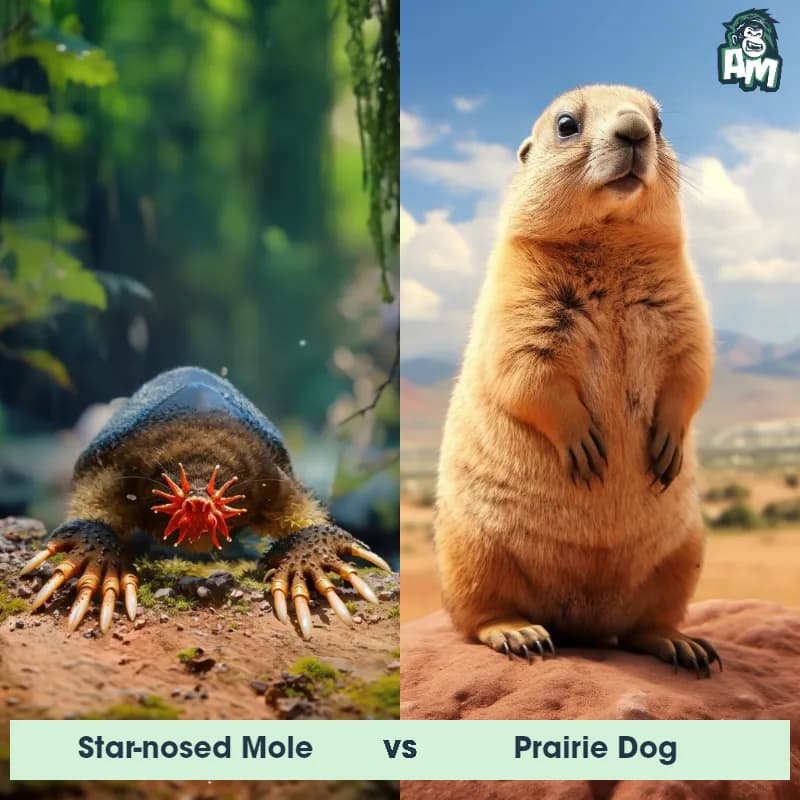Star-Nosed Mole vs Prairie DogSee Who Wins

Welcome to this exciting matchup between the Star-Nosed Mole and Prairie Dog! These two animals are ready to go head to head in a three-round fight. Let's see who will come out on top in this battle of the burrowers.
Contender 1: Star-Nosed Mole
The Star-Nosed Mole, scientifically known as Condylura cristata, is a small mammal found in the wetlands of eastern North America. It is easily recognizable by its unique star-shaped nose, which is used to detect prey. The nose consists of 22 pink fleshy appendages known as "rays," each covered in numerous touch-sensitive sensors called Eimer's organs. This extraordinary nose allows the mole to navigate and forage quickly in dark, aquatic environments. The Star-Nosed Mole has a cylindrical body with dense velvety fur, tiny eyes, and shovel-like claws for efficient digging.
Fun Fact: The Star-Nosed Mole possesses one of the most incredible sensory organs, as it can locate and consume prey in less than a quarter of a second!
Contender 2: Prairie Dog
The prairie dog is a type of burrowing rodent native to the grasslands of North America. These small creatures have a stout body, a small head, and short legs, which are perfect for their lifestyle underground. They typically have a coat that ranges from brown to reddish in color. Prairie dogs are highly social animals, known to live in large colonies or 'towns' which can consist of hundreds or even thousands of individuals, and their intricate burrow systems can cover large areas.
Fun Fact: Prairie dogs have a complex communication system, using different sounds and calls to warn their colony about the approach of different types of predators.
Matchup Stats
| Star-Nosed Mole | Prairie Dog | |
|---|---|---|
| Size | 6-8 inches (15-20 cm) | 12-16 inches (30-40 cm) |
| Weight | 1-2 ounces (30-60 grams) | 1-3 lbs (0.45-1.36 kg) |
| Speed | 3 mph (4.8 km/h) | 35mph (56km/h) |
| Key Strength | Speed and agility | Ability to burrow quickly to escape danger |
| Biggest Weakness | Lack of physical strength | Small size and lack of strong defensive capabilities |
Current Votes
Star-Nosed Mole vs Prairie Dog
See Who Wins
View More Matches
Looking For More?
Similar Matches
Scientific Stats
| Star-Nosed Mole | Prairie Dog | |
|---|---|---|
| Scientific Name | Condylura cristata | Cynomys |
| Family | Talpidae | Sciuridae |
| Habitat | Wetlands | Grasslands |
| Geography | Eastern North America | North America |
| Diet | Insects, worms, and small invertebrates | Herbivore (Grasses, seeds, and occasionally insects) |
| Lifespan | 4 years - 6 years | 3 years - 5 years |
Key Differences between Star-Nosed Mole and Prairie Dog
- Tail: Star-nosed moles have short, hairless tails, whereas prairie dogs have long, bushy tails that they use for communication and balance.
- Color: Star-nosed moles have dark brown fur and a unique star-shaped pink fleshy appendage on their nose, while prairie dogs have a tan or light brown fur with white markings on their face and belly.
- Social Behavior: Star-nosed moles are solitary and territorial animals, whereas prairie dogs are highly social creatures that live in complex burrow systems and exhibit communal behaviors.
- Size: Star-nosed moles are much smaller, typically measuring 4 to 5 inches in length, while prairie dogs are larger, ranging from 12 to 16 inches.
- Habitat: Star-nosed moles are solitary creatures that burrow underground in moist, woodland areas, while prairie dogs live in colonies in open grasslands.
- Diet: Star-nosed moles are insectivores, using their unique nose to detect prey, while prairie dogs are herbivores, primarily feeding on grasses, seeds, and roots.
































